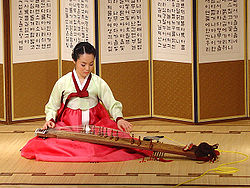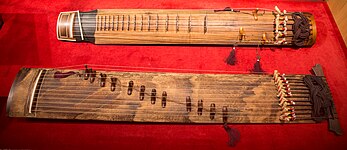Gayageum
|
Sanjo gayageum concert, KWON Eun Kyung ( 권은경 ), Seoul 2007 |
|
| Korean spelling | |
|---|---|
| Korean alphabet : | 가야금 |
| Hanja : | 伽 倻 琴 |
| Revised Romanization : | Gayageum |
| McCune-Reischauer : | Kayagûm |
Gayageum even Kayagum ( Korean 가야금 ), is in the classical Korean music played Wölbbrett zither . She represents the national musical culture of Korea in a leading position .
The gayageum was according to legend by King Kasil modeled on the Chinese zither guzheng invented. The instrument can be traced back to the year 551 AD, when a refugee from the land of Kaya fled to Silla for fear of annexation and gave the king the new instrument Kayas, a gayageum.
There are two traditional types of gayageum : the jeongak gayageum (“Hof- gayageum ”, also popkum and pungnyu gayageum ) and the sanjo gayageum . Typical of the jeongak gayageum is the larger body, which is around 160 centimeters long and 30 centimeters wide, and the lower end of the instrument, reminiscent of ram horns. The sanjo gayageum is about 142 centimeters long and 23 centimeters wide and was developed for the Sanjo style in the 19th century . The closer arrangement of the strings and the shorter length of the instrument facilitate the faster passages of the sanjo. Both instruments have twelve silk strings (now also nylon strings) and twelve movable bridges that are shaped like the feet of wild geese.
- Korean vaulted board zither - Gayageum - 가야금
Sanjo ajaeng and Sanjo gayageum (below), 2017
six-string geomungo (top) and twelve-string jeongak gayageum, 2017
The mood of the sanjo gayageum is G - c - d - g - a - c 1 - d 1 - e 1 - g 1 - a 1 - c 2 - d 2 . There are two common notations. If the treble clef is used for notation, the notation is in F , so the notes sound a fifth lower than notated. If the mezzo-soprano clef is used for the notation, the notes sound as if they were notated. In contrast to the guzheng or Japanese curved board zither koto , the strings are plucked with the fingertips or nails of the right hand. The sound is soft and singing. The tone design of the left hand is similar to the way the koto is played .
The gayageum is usually accompanied by the double-headed hourglass drum janggu .
The gayageum may have influenced the Japanese wagon . Furthermore, the gayageum is related to the Korean string zither ajaeng , the Mongolian yatga and the Vietnamese đàn tranh .
literature
- Robert C. Provine: Kayagŭm. In: Laurence Libin (Ed.): The Grove Dictionary of Musical Instruments. Vol. 3, Oxford University Press, Oxford / New York 2014, pp. 122f
Web links
- The Kayagûm. ( Memento from October 6, 2014 in the Internet Archive ) Cross Sound
- Craig Stuart Sapp: Kayagum. In: Koto Sound Dictionary. August 30, 2003, accessed December 14, 2012 .
- Korean Musical Instruments. People's Korea, April 8 & 16, 1998. In: World History Archives. Hartford Web Publishing, January 2, 2004, accessed December 14, 2012 (American English).




